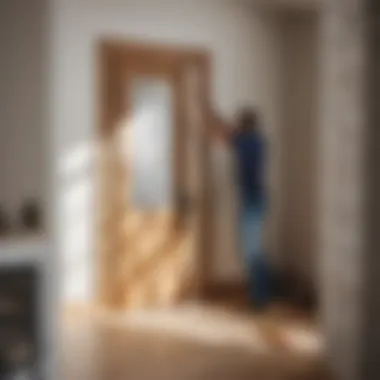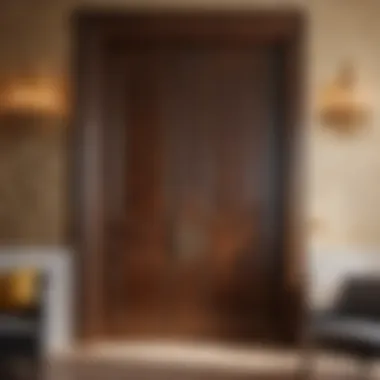Materials:
- Interior door of choice (specify material and dimensions)
- Hinges (quantity based on door size)
- Door handle/lockset
- Screws/nails
- Screwdriver/Drill
- Tape measure
- Level
- Shims
- Hammer
- Safety glasses
DIY Steps:
- Measure the door frame accurately to ensure the right fit for the new door.
- Remove the old door carefully, saving any reusable components.
- Install hinges on the new door according to manufacturer instructions.
- Place the door in the frame, using shims to ensure it is level and plumb.
- Attach the door handle/lockset as per instructions.
- Secure the door in place with screws/nails.
Technical Aspects:
- Timing: Allocate a few hours for this project, depending on experience.
- Tools: Ensure you have a drill, screwdriver, hammer, level, and safety gear.
- Techniques: Use shims for precise leveling and follow the manufacturer's instructions for installation intricacies.
DIY Project Process:


- Begin by measuring and preparing the door frame.
- Remove the old door and any hardware.
- Install the hinges and position the new door in the frame.
- Use shims for alignment and ensure the door swings smoothly.
- Attach the handle/lockset securely.
Troubleshooting Tips:
- If the door sticks, check for misalignment and adjust shims accordingly.
- Ensure all hardware is tightened properly to prevent future issues.
Introduction


Interior door installation is a crucial aspect of home improvement projects, contributing significantly to the overall aesthetics and functionality of a living space. In this comprehensive guide, we will delve deep into the various factors that impact the cost of interior door installation, providing readers with valuable insights to make informed decisions. From selecting the right type of door to understanding material quality and labor costs, each element plays a vital role in determining the total expenses involved in this process.
Defining Interior Door Installation
When we talk about interior door installation, we are referring to the process of fitting or replacing doors within a property's interior spaces. It goes beyond just hanging a door; it involves ensuring proper alignment, functionality, and visual appeal to enhance the overall look and feel of a room.
For housewives and homeowners, understanding the intricacies of interior door installation is essential to make informed choices when renovating or upgrading their living spaces. Factors such as door types, materials, and labor go hand in hand in influencing the cost of the installation project.
Factors Affecting Cost


In the realm of interior door installation, the understanding of the various factors that influence costs is paramount. These factors play a crucial role in determining the overall expenses that homeowners may incur during their door installation process. By comprehensively delving into the types of doors, material quality, labor costs, and additional expenses, individuals can gain clarity on where their budget allocation should focus. Equipped with this knowledge, they can make informed decisions that align with their preferences and financial capacities.
Type of Door
Solid Wood Doors
Solid wood doors stand out for their timeless elegance and robustness. Their inherent durability and classic appeal make them a preferred choice for many homeowners looking to elevate the aesthetics and quality of their living spaces. The natural beauty of solid wood doors adds a touch of sophistication and warmth to any room. However, it's essential to note that solid wood doors may require more maintenance compared to other door types, impacting long-term upkeep costs.
Hollow Core Doors
Hollow core doors offer a more budget-friendly option while still providing decent sound insulation and privacy. Their lightweight construction makes them easy to install and cost-effective. Despite being less sturdy than solid wood doors, hollow core doors are a practical choice for interior spaces where soundproofing is not a crucial factor. Homeowners appreciate the affordability and versatility that hollow core doors bring to their interior design projects.
Glass Doors
Glass doors introduce a modern and sleek aesthetic to any environment. They enable natural light to flow through rooms, creating an open and airy ambiance. Glass doors are ideal for spaces where transparency and visual connectivity are desired, such as offices or living areas. While stylish and contemporary, glass doors may require more frequent cleaning and maintenance to preserve their transparency and appeal.
Material Quality
Labor Costs
Additional Expenses
Hardware Costs
Finishing Costs
Estimating Material Costs
Estimating material costs is a fundamental aspect of calculating the total cost of interior door installation. This section delves into the intricacies of material estimation, providing readers with valuable insights into this essential component of the pricing equation.
When estimating material costs, homeowners need to consider the type and quality of the door they prefer. Solid wood doors, hollow core doors, and glass doors each come with their own price points, influencing the overall material expenditure. Understanding the variations in material costs based on the door type allows individuals to make informed decisions aligned with their budget and preferences.
Moreover, material quality plays a significant role in determining the overall cost of interior door installation. Higher-grade materials typically come at a higher price, impacting the total material expenses. By guiding readers through the process of estimating material costs, this section equips them with the knowledge to select materials that balance quality and affordability for their project.
In essence, estimating material costs is a strategic step in the interior door installation journey. By grasping the nuances of material pricing and its impact on the total cost, homeowners can budget effectively, make informed choices, and ensure a successful outcome for their door installation endeavors.
Choosing the Right Professionals
When it comes to interior door installation, the choice of professionals to work with is a crucial decision that can significantly impact the outcome of the project. Selecting the right professionals ensures that the installation is done correctly, efficiently, and in a timely manner. Experienced professionals possess the necessary skills and expertise to handle the complexities of installing various types of doors, from solid wood to glass options. By entrusting the installation to professionals, homeowners can have peace of mind knowing that the job will be completed to a high standard.
Working with Contractors
Factors to Consider
One of the key aspects to consider when working with contractors for interior door installation is their level of experience and reputation in the industry. A contractor's track record and portfolio of previous projects can offer valuable insights into their capabilities and reliability. It is essential to look for contractors who specialize in door installation and have a proven track record of delivering excellent results.
Contractors who are well-versed in handling different types of doors and materials can provide valuable recommendations and guidance throughout the installation process. Moreover, considering factors such as licensing, insurance coverage, and warranty offerings can help homeowners make informed decisions when selecting a contractor for their project.
Choosing a contractor who is transparent and communicative in their approach can facilitate a smoother and more efficient installation process. Effective communication ensures that homeowners are kept informed of the progress, any potential challenges, and timelines throughout the project. By evaluating these critical factors, homeowners can partner with the right professionals for their interior door installation needs.
DIY vs. Professional Installation
When it comes to interior door installation, one crucial decision that homeowners face is whether to opt for a DIY approach or hire professional installers. This section delves deep into the significance of this topic within the context of our comprehensive guide on the cost of interior door installation. By examining specific elements, benefits, and considerations of DIY versus professional installation, readers can make an informed choice that aligns with their needs and preferences.
Pros and Cons of DIY
Embarking on a do-it-yourself interior door installation project offers certain advantages and disadvantages. On the positive side, tackling the installation personally can lead to cost savings, a sense of accomplishment, and the ability to customize the process to suit individual tastes. However, DIY enthusiasts should be aware of the potential drawbacks, such as the risk of errors, lack of professional expertise, and the time and effort required to complete the task to a satisfactory standard.
Benefits of Professional Installation
On the other hand, opting for professional installation services brings a host of benefits. Professionals have the knowledge, skills, and tools to execute the installation efficiently and effectively, ensuring a high-quality outcome. Additionally, hiring experts can save homeowners time and hassle, as the project is handled with precision and expertise. Professional installers also offer guarantees on their work, providing reassurance and peace of mind to homeowners.
Conclusion
Interior door installation is a crucial aspect of home improvement, impacting both the functionality and aesthetics of a space. As demonstrated throughout this comprehensive guide, the cost of interior door installation is influenced by various factors, from the type of door chosen to the quality of materials used and labor expenses incurred. Understanding these costs is essential for homeowners embarking on renovation projects to plan their budgets effectively. By analyzing the nuances of material choices, labor costs, and additional expenses like hardware and finishing, individuals can make informed decisions that align with their financial capabilities and design preferences.
Key Takeaways
- Material quality plays a significant role in determining the overall cost of interior door installation. Solid wood doors are typically more expensive than hollow core doors or glass doors, but they offer durability and a timeless aesthetic.
- Labor costs can vary based on the complexity of the installation process and the expertise of the professionals hired. It is advisable to obtain multiple quotes from reputable contractors to compare prices and services offered.
- DIY installation may appeal to individuals seeking cost savings, but it comes with risks and challenges that could impact the final result. Professional installation guarantees precision and quality craftsmanship, enhancing the longevity and performance of the doors.
- It is essential to consider all expenses involved in interior door installation, including hardware costs and finishing expenses, to anticipate the total budget required for the project.





